SPECIAL D-DAY 80th Yr Anniversay !
Of the main landing vessels that made the Armada of Operation Overlord on June, 6th, 1944, were many LCTs, especially the LCT-5/6 family of landing craft. Denominaiton at that stage was “Landing Craft, Tank” and they constituted a missing link between the infantry alone LCVP and LCIs and the larhe LSTs. These were also the largest of the family of landing craft in the allied inventory. Called “craft” and not “ship” despite its size and tonnage (300 tonnes) because it could be transported by LSTs, two in fact. The Landing Craft, Tank was the largest of all US shipborne amphibious – craft; it could be carried only by an LST, on deck, and then launched broadside, empty.
They were not very slow, between 7 and 11 knots and their range was adapted to the mission. The British made a bit less than the US, which provided the LCT-5, 6 and 7 (renamed LSM) an the British the LCT Mark 1, 2, 3, 4 and 8. This was an incremental evolution frolm the will of Churchill to carry 40t heavy tanks on landing crafts, to their use in Korea and Vietnam. Many ended with navies across the globe via MDAP as well in the cold war. Their versatility had them declined also into a large variety or rocket, artillery, FLAK or hospital variants, close to the beaches for direct support. They were critical during Operation Overlord. #dday #normandy #normandylandings #operationoverlord #overlord #ww2 #landingnormandy #usnavy #royalnavy
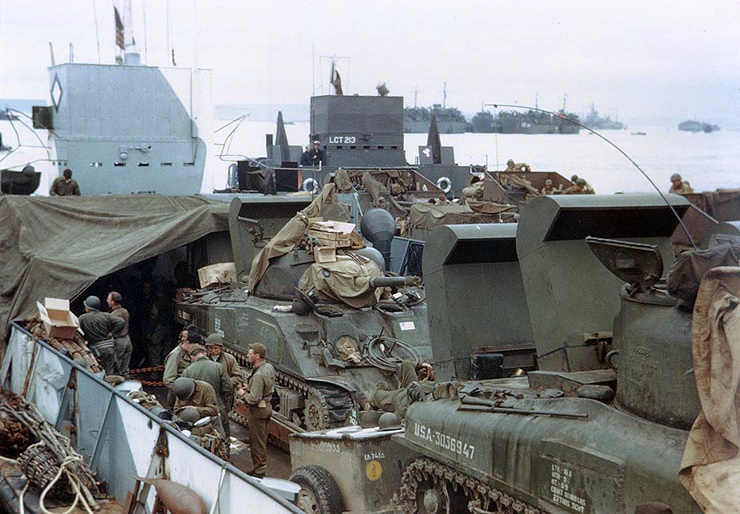
The Landing Craft, Tank was the largest of all US shipborne amphibious – craft; it could be carried only by an LST, on deck, and then launched broadside, empty. Alternatively, the LCT could be carried in sections, each weighing less than 50 tons, which were buoyant and so could be bolted together in the water. The class originated with a British request for a US version of a Thornycroft design for a tank lighter about 100ft long, capable of carrying heavy and medium tanks; the Admiralty Staff Requirement of November 1941 called for a capacity of six 10-ton trucks or three 50-ton tanks or six 27-ton medium tanks, two abreast. They were to serve primarily as point-to-point lighters for a European invasion mounted from the United Kingdom, and were not expected to be seaworthy enough for an Atlantic crossing; in fact one important function of the LSD was to transport loaded LCTs over great distances.
The US LCT design based broadly on the Admiralty requirement was ready within a month of receipt of the Admiralty requirement, and production was very rapid. The initial design was designated Mk V, as there were already four types of much larger British tank transports, roughly comparable to the later US LSM. The initial production LCT(5) was followed by an enlarged LCT(6), designed to perform a secondary function as a causeway between an LST and the Shore: it had a detachable stern plate, with a lip beneath it for the LST ramp to engage; the LCT(5) superstructure was split in half to permit vehicles to run the enure length of the craft. 500 LCT(5)s were succeeded by 965 LCT(6)s all being completed between 29 June 1942 and 22 December 1944. Postwar survivors were reclassified LCU (for Utility) and additional craft of the same type were built under several postwar programmes.
The LCTs were the smallest US landing craft to receive numbers in their own right, as LCT 1-1465. They began with the designator YTL, for yard (ie local, or Short-range) tank lighter. LCT Mk 7 became the LSM, the Landing Ship, Medium, and LCT(8) was a British type unrelated to the US designs. Six LCT(6)s were converted to underwater object locators, AMC(U) 1-6, in 1945. #dday #normandy #operationoverlord #normandylandings #ww2 #landingcrafttank #usnavy
Alternatively, the LCT could be carried in sections, each weighing less than 50 tons, which were buoyant and so could be bolted together in the water. The class originated with a British request for a US version of a Thornycroft design for a tank lighter about 100ft long, capable of carrying heavy and medium tanks; the Admiralty Staff Requirement of November 1941 called for a capacity of six 10-ton trucks or three 50-ton tanks or six 27-ton medium tanks, two abreast. They were to serve primarily as point-to-point lighters for a European invasion mounted from the United Kingdom, and were not expected to be seaworthy enough for an Atlantic crossing; in fact one important function of the LSD was to transport loaded LCTs over great distances.
The US LCT design based broadly on the Admiralty requirement was ready within a month of receipt of the Admiralty requirement, and production was very rapid. The initial design was designated Mk V, as there were already four types of much larger British tank transports, roughly comparable to the later US LSM. The initial production LCT(5) was followed by an enlarged LCT(6), designed to perform a secondary function as a causeway between an LST and the Shore: it had a detachable stern plate, with a lip beneath it for the LST ramp to engage; the LCT(5) superstructure was split in half to permit vehicles to run the enure length of the craft. 500 LCT(5)s were succeeded by 965 LCT(6)s all being completed between 29 June 1942 and 22 December 1944. Postwar survivors were reclassified LCU (for Utility) and additional craft of the same type were built under several postwar programmes.
The LCTs were the smallest US landing craft to receive numbers in their own right, as LCT 1-1465. They began with the designator YTL, for yard (ie local, or Short-range) tank lighter. LCT Mk 7 became the LSM, the Landing Ship, Medium, and LCT(8) was a British type unrelated to the US designs. Six LCT(6)s were converted to underwater object locators, AMC(U) 1-6, in 1945.
Development
The landing craft, tank (LCT) (or tank landing craft, TLC) was an amphibious assault craft tailored to land tanks directly on beachheads. The concept was initially developed by the Royal Navy but as the need for these rose woth new operations, the US indutry was mobilized. Albeit there the LCT(5) and LCT(6) basically, there were a series of versions. The aconyms were inverted for both users, “tank landing craft” (TLC) for the British, until “LCT” became standard. The design was successful enough to be used under different designations such as LCU postwar, notably in the Korean and Vietnam Wars. They were widely exported as well.
Development of such vessels went back in fact to British tests in 1926. That year the RN tested its first motor landing craft (MLC1), a modest 16 tons, draught 6 feet 6 inches (1.98 m), 6 knots (11 km/h; 6.9 mph). It was however judged a bit small was turned into later the landing craft mechanised (LCM) capable of carrying wheeled vehicles.
Prime minister Winston Churchill in mid-1940 however urged the creation to the War Department of a specific tank-carrying landing craft.
Let there be built great ships which can cast upon a beach, in any weather, large numbers of the heaviest tanks.
Winston Churchill, Memo to War Department, 1940
It was planned to have a top speed 10 knots (19 km/h; 12 mph) based on 700 hp (520 kW) power. This first draft was Designated LCT Mark 1, with 20 ordered in July 1940 and 10 in October 1940. They saw action notably at dieppe in 1942.
Thus, were built small series of the LCT Mark 1 (30, 1940), Mark 2 (73, 1941), Mark 3 (235, 1941), Mark 4 (865, 1941-42), and the US built Mark 5 (or LCT(5)) 470, 1942-44, and Mark 6 (LCT(6)) being the largest production at 960 from 1943 to 1944, superseding other models. The Mark 7 (558 made) was basically a LSM (same basic design as the LCI), the Mark 8 a 225ft vessel for the pacific (186 ordered, 31 completed) and the Mark 9 being an evern larger variant planned but not built.
LCT Mark 1 (1940)
The first LCT Mark 1 was launched by Hawthorn Leslie at Hebburn on Tyne. It was back in November 1940, designed to land three 40t envisaged for the British Army (such as the Churchill) in two feet and six inches (80 cm) of water on a 35° gradient beach. Ither than that 40-ton tanks, the same LCT was tailored to load six 25-ton tanks (stationed in tandem, three rows) or same with 16-ton tanks such as the Stuart (later) and Mark VI (then).
Forward draught was 3 feet forward, 5 feet 9 inches aft. They used the principles of a floating dock, with watertight side pontoons on either side, joined by a tank deck below the waterline. The tanks were swept up above the waterline near the bow and then fell away to the ramp. These LCT Mark I were powered for production by two dependable Hall Scott Defender petrol engines rated for 500 hp each. They were built in four four sections that could be dismounted in orfer to be shipped easier as merchant deck cargo to the Eastern Mediterranean. Thirty were ordered.
These thirty ships were named Landing Craft tank and several series were devised, they arrived by late 1940 later renamed LCT(1). The cellular steel construction with rapid fixing devises allowed split up for easy transport but they were individually far too large for rail transport. These were short range vessels and early one in the war, half were sunk, an heavy tribute to the early amphibious operations. Their powerplant was essentially the same as on the Fairmile C boats but due to the heavier weight, they ended much slower of course. The armament was fixed as what is marked below.
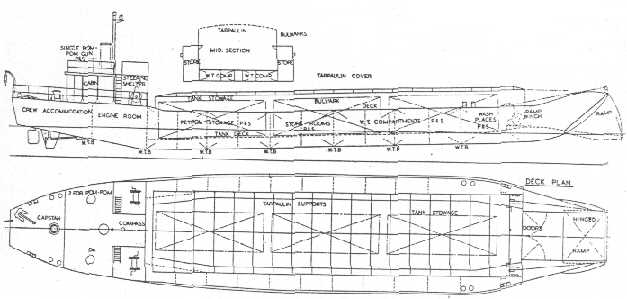
⚙ specifications LCT Mark I |
|
| Displacement | 372 long tons (378 t) |
| Dimensions | 152 x 29 x 5 ft 9 in aft (46 x 8.8 x 1.75 m aft) |
| Propulsion | 2× 350 hp (261 kW) Hall-Scott petrol engine, 2 shafts |
| Speed | 10 knots (19 km/h; 12 mph) |
| Range | 900 nmi (1,700 km; 1,000 mi) |
| Armament | 2 × single 2-pounder pom-pom |
| Capacity | 250 long tons (254 t), 3 heavy, 6 med/light tanks, 500 troops |
| Protection | Wheelhouse: 15 mm, Gunshield: 20 mm |
| Air Group | |
| Crew | 12 (2 officers, 10 enlisted men) |
LCT Mark 2 (1941)

A Crusader tank landing from LCT-124 during tests of a portable concrete roadway 26 April 1942.
Given early experience with the thirty Mark I, ideas were not in shortage to improve the design. This led to the LCT Mark 2, wich was longer and wider and this time re-engined with three Napier Lion petrol engines. Hall-Scotts engines were indeed in high demand for more motor gunboats of the Coastal Forces. They were not much faster, just half a not, but at 2,700 nautical miles (5,000 km; 3,100 mi), they had thrice the range, meaning for D-Day they could sail from any corner of the British Isles straight to Normandy at full sped if needed.
Their beam had been increased by 2 ft (0.61 m) to allow a much greater cargo capacity and add lighter vehicles to tanks, so a large payload. Two heavy trucks could easily side by side in three rows. As for tanks, the Mark Is could only carry three Valentine tanks while the Mark 2 could carry even of these. They carried three Medium Tanks such as the Sherman or seven light ones (or three tons trucks).
The first craft were ordered in December 1940, completed in March 1941 and in all, the seventy-three Mk.2s built did not diverged much. As these LCTs would be required in huge numbers with ship builders already at full capacity, structural steelwork firms were also submitted tenders, and entered the program by prefabricating as much as the structure as possible, shipped then to assembly points. Even former shipyards reopened to assemble these. The modular solution, with four sections to facilitate shipping was retained.
Numbered TLC-100 to TLC-172 these larger 3-shafts versions were also declined in two-shaft variants with Maxman diesels giving them 860 hp, enough for 9 knots but a superior range. Later some 3-shaft versions were given three Paxman diesels, for 1,500 bhp and 11 knots, and 10,800 petrol gallons. On the 72 deployed, 19 were lost in action.
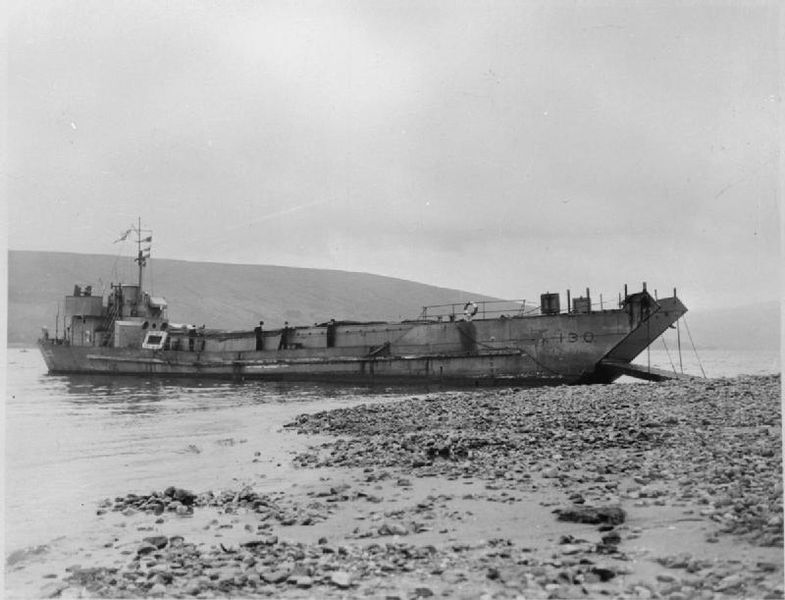
LCT Mark 2 beached with ramp down at Inveraray, Scotland. Coote, R G G (Lt), Royal Navy official photographer. IWM

LCT(2) – MoD (Conway’s)

⚙ specifications |
|
| Displacement | 590 short tons (535 t) |
| Dimensions | 159 ft 11 in x 30 x 3 ft 8 in (48.74 x 9.1 x 1.12 m) |
| Propulsion | 3× 460 hp (343 kW) Paxman diesels or 350 hp (261 kW) Napier Lion petrol engines |
| Speed | 10.5 knots (19.4 km/h; 12.1 mph) |
| Range | 2,700 nmi (5,000 km) |
| Armament | 2× 2-pdr pom-pom/2× Bofors 40 mm guns |
| Protection | Wheelhouse: 2.5 in (64 mm), Gun shield: 2 in (51 mm) |
| Capacity | 5× 30-ton/ 4 × 40-ton/ 3× 50-ton tanks/ 9 trucks/ 250 long tons (254 t) cargo |
| Crew | 12 |
LCT Mark 3 (1941)

Landing Craft Tank Mk III LCT (3) (MOD 35). Copyright: © IWM. Original Source
The LCT(3) were basically LCT(2) with an extra 32 feets (9.8 m) section amidships. This started as a builder’s experiment and proposal. With this extra 32 ft section added in May 1941 on a Mark 2 as fifth building section (parallel sided), this made the overall hull reach 192 feet (59 m), much longer, but since this meant extra weight, they ended even slower than the Mark Is. But range was preserved, giving them much flexibility. The slow speed was alleviated by later trials: Late production boats had indeed two shaft sterling petrol engines for 100 bhp and this time 10.85 knots but less fuel, 5760 gallons. The original carried more, but traded range for less speed.
But this meant capacity also went to up eleven light tanks (30 tonnes and less) or six or eight Valentines or M4 Sherman medium tanks or eleven 3-tons lorries, or five Churchill infantry tanks to compare to the three on the Mark I. 166 craft were buit using two Paxman diesels, 71 were built in the winter of 1943-1944 to a slightly revised pattern using two Sterling Admiral petrol engines. These are usually referred to as Mark 3* or 7000 series as they had pennant numbers from 7000 upwards. LCT7074, currently preserved in Portsmouth, UK, is of this type.
They could be disassembled in these five sections still for transport. Two hundred and thirty-five Mk. 3s were built and production lasted until 1944, with a total of 200 ships, numbered 300 to 499 and 7001 to 7150. 31 were lost during the war.
Protection was the same, as Armament but it also included the infamous FAST AERIAL MINE (FAM) APPARATUS AD TYPE L MK. 1. This was a fancy name for a rocket, which fuse problem was solved by a remote cable detonation. The Mark 3 was accepted on 8 April 1941.
⚙ LCT(3) specifications |
|
| Displacement | 640 long tons (650 t) |
| Dimensions | 192 x 30 x 3 ft 10 in (59 x 9.1 x 1.17 m) |
| Propulsion | 2 shafts 460 hp (343 kW) Paxman diesels or Sterling petrol engines |
| Speed | 9 knots (17 km/h; 10 mph), see notes |
| Range | Same as above |
| Armament | same plus 2x ‘Fast Aerial Mines’ |
| Protection | Like above |
| Capacity | 300 long tons (305 t) of cargo, see notes |
| Crew | 12 |
LCT Mark 4 (1942)
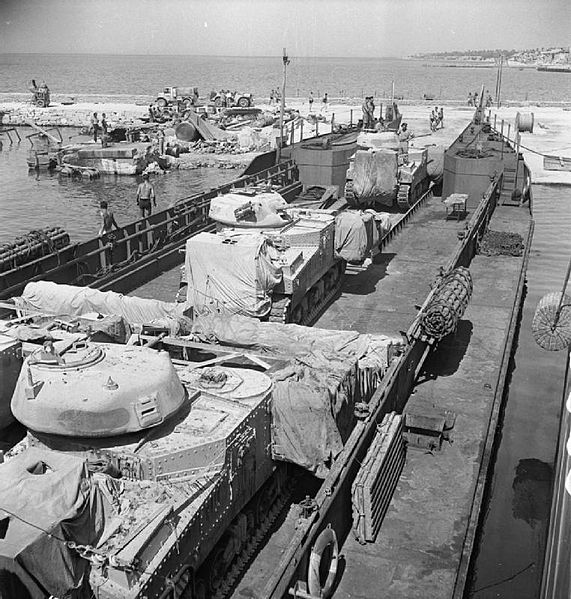
M3 Grant about to be rolled off a Mark 4 in North Africa in January 1943.
The Mark 4 this time was widened to 38 ft 9 in (11.81 m) compared to 30 ft (9.1 m) for the Mark 3. They were intended to remain stable when corssing the fast-watered English Channel (range was halved), and had a displacement of 586 tons. These were powered by the same two 460 hp Paxman diesels, adopted after comparisons on the Mark 3. Capacity now reached 350 tons, which translated into no less than nine M4 Sherman or six Churchill tanks. That was close to LST territory, which were now built in the US but unlike the latter had to cross the Atlantic… They were the slowest so far, only capable of 8 knots, easy prey for German S-Boote.
The Eight hundred and sixty-five Mk.4s built ended as the largest British built LCTs of the war. Their draught was reduced to 3 ft 8in forward, 4 ft aft, helped by the lareger beam and thus, greater buoyancy, so to allowing beaching on flatter ground, exactly the conditions needed for Normandy. Of all types were were the best suited for D-Day Operations. Their tank deck was brought above the waterline this time, and construction after all these englargements became somewhat flimsy with a lot of torsion (and that included a general degradation in buiding quality in the UK) so many broke their backs on uneven beaches or heavy seas. Still they proved excellent in service and later versions were stiffened, some making the trip to India via Suez in 1945 to help last operations in Burma. They were no longer made by large sections but this time built from prefabricated kits, assembled in riverside yards.
Ship builders were not sollicited to free them up for more imprtant works, but this initially made little to give confidence. These vessels of lighter construction overall had to be much strenghtened later compared to the LCT(4). Still, 865 was assembled between 1941 and the fall of 1942, which for the British industry at large was quite appreciable. Largest effort before lend-lease provisions.
Variant:
Some ended tailor-built as gunboats for close support and numbered 500 to 1364 which gaves us a total number of 864 vessels, with 39 losses.
The Mark 4 was slightly shorter and lighter with wider beam for channel operations but when tested early assault operations, the first occasion was the Allied raid on Dieppe in 1942, and its lack of manoeuvring ability led to prefer a shorter overall length for future designs, at this point to be built in the United States, such as the LCT Mark 5.
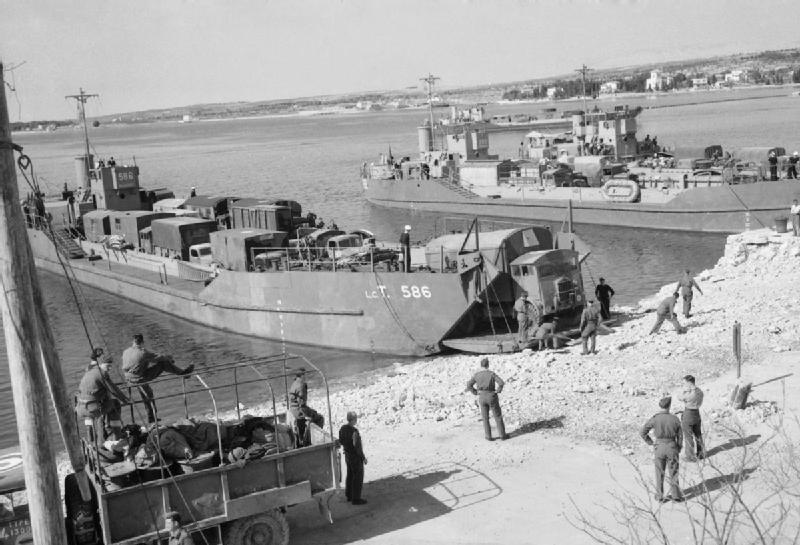
LCT Mark 4 unloading trucks and supplies in Italy, Balkan air Force 1944 (IWM)

⚙ Mark 4 specifications |
|
| Displacement | 586 long tons (595 t) |
| Dimensions | 187 ft 3 in x 38 ft 9 in x 3 ft 8 in (57.07 x 11.81 x 1.12 m) |
| Propulsion | 2 shafts 460 hp (343 kW) Paxman diesel engines |
| Speed | 8 knots (15 km/h; 9.2 mph) |
| Range | 1,100 nmi (2,000 km) |
| Armament | 2× Oerlikon 20 mm/2× 40 mm guns |
| Protection | 2 in (51 mm) Gun shield/Wheelhouse |
| Capacity | 350 long tons (356 t) of cargo |
| Crew | 12 |
LCT(5)

LCT-202 off the coast of England in 1944 prior to D-Day
These were the first US-built ones. A good example of “reserve lend lease” on the concept level, these managed to gap a need between, the large LSTs and too small LCVPs only carrying jeeps.
When the United States entered the war in December 1941, there was an absence of amphibious vessels for the Army, and even for the Marines which had to make due with standard ship born sloops and rafts. Having little time to prepare for their foirst operations, Guadalacanal in August and North Africa in November, the US asked for informations on British designs already in existence. Still, the infantry landing issue was quickly solved with the help of local industrialists such as Lousiana based Higgins, even the larger LCVP would only carry at best a jeep.
An agreement withing the top brass was found to provide a suitable design that could be followed by US industry, and that was K.C. Barnaby of Thornycroft, which proposed his own design of double-ended LCT, to work with landing ships (LST) also in the works. The Bureau of Ships started from there and drew up plans for landing craft based on these suggestions. This was simplified however as a single ender, with one ramp. By early 1942, this led to the LCT Mark 5 (reclassed later as LCT-5). This was 117-foot (36 m) craft, so much shorter than previous British designs. It could still accommodate five 30-ton or four 40-ton tanks, or up to 150 tons of cargo.
It was down to 286-ton and could be disassembled into three separate water-tight sections for crossing on any cargo ship, or pre-assembled on the flat deck of a LST. That way, they were perforc for the planned operations in North Africa as LSTs were supposed to do the entire trip from ports on the east coast to the beaches of north africa, or at least a gathering point to assemble these LCTs.
But they could also be carried assembled and launched by heeling the LST on its beam to let its slide off its chocks into the sea. This was also possible for a cargo ship to lower each section into the sea, then joined together on the spot. This gave more flexibility than any previous design.
The general design showed a large “flatbed” covering 90% of the lenght, then a rear upper deck with a squared wheelhouse closer to the transom stern. It was armoured, protected for the lower inside level, but commands were doubled to steer these from the roof open bridge only protected by canvas. The two defensive weapons were generally 20 mm Oerlikon with shields, sometimes replaced at the end of the war with twin mounts, on two locations either side of the wheelhouse sometimes doubled by pintle-mounted 0.5 inch Browning M2 HMGs.
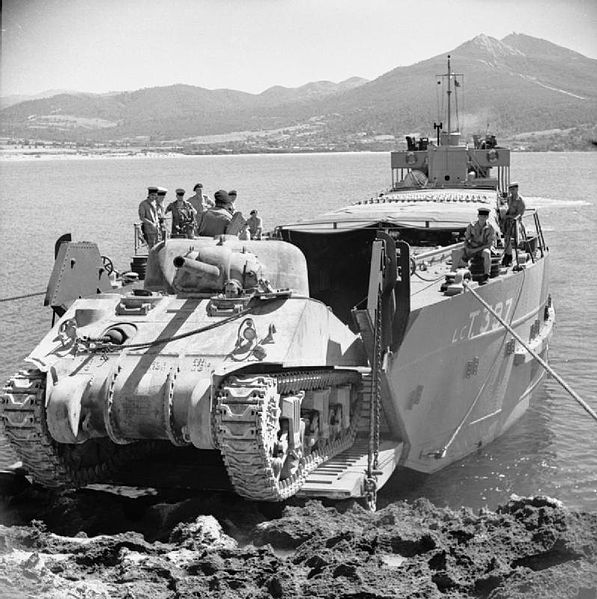
LCT-397 landing a Sherman in North Africa, 1943
Production
New York Shipbuilding, NJ: 100
Quincy Barge Builders, IL: 66
Bison Shipbuilding, NY: 52
Manitowoc, WI: 36
Kansas City Steel, KS: 36
Mount Vernon Bridge, OH: 36
Decatur Iron & Steel, AL: 33
Pidgeon Thomas Iron Works, TN: 31
Omaha Steel, NE: 24
Missouri Valley Bridge, KS: 20
Darby Corporation, KS: 20
Jones & Laughlin, PA: 16

LCT-397 rolling off a Lend-Lease Sherman, North Africa 1943
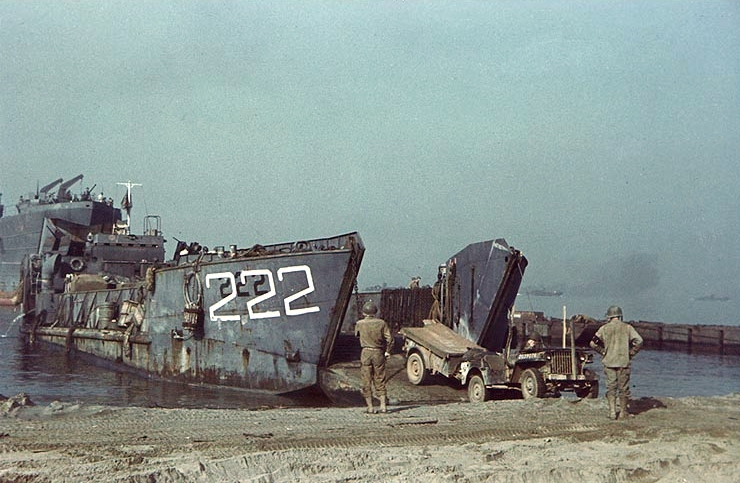
LCT-222 (Mark 5) releasing a jeep in north Africa, 1943
The Royal Navy obtained a total of 172 of these were sent via lend-lease, US-built. 29 were lost in action.
After the war, 11 were used in 1950-1960 by the Polish Navy amphibious forces. They had BDS and then ODS pennants with former numbers.
⚙ LCT(5) specifications |
|
| Displacement | 286 short tons (259 t) when landing |
| Dimensions | 117 ft 6 in x 32 2 ft 10 in/4 ft 2 in (35.81 x 9.8 x 0.86/1.27 m) |
| Propulsion | 3 shafts 225 hp (168 kW) Gray marine diesels |
| Speed | 8 knots (15 km/h; 9.2 mph) |
| Range | 700 nmi (1,300 km) at 7 kn (13 km/h) |
| Armament | 2× 20 mm Oerlikon AA gun |
| Protection | Wheelhouse 2.5 in (64 mm), Gun shield 2 in (51 mm) |
| Payload | 5× 30-ton/4× 40-ton/3× 50-ton tanks/9 trucks/150t (136 t) cargo |
| Air Group | |
| Crew | 13 (1 officer, 12 enlisted men) |
LCT(6)
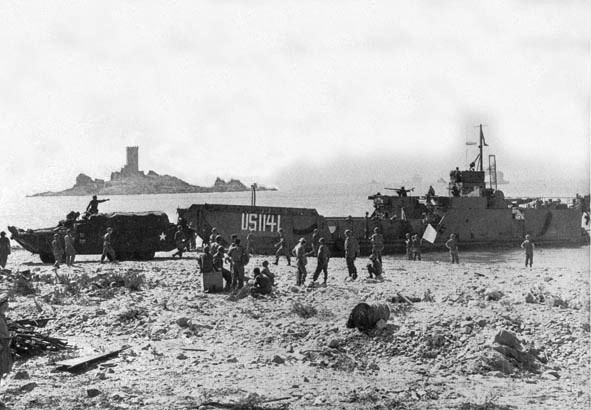
US Landing Operation Dragoon (Provence, Southern France), DIKW and supplies out of USS LCT(6)-1141 at St Raphaël, Golden island.
About the same size as the previous LCT(5) they were slightly lighter, and configured differently with the entire lenght from the bow ramp to the stern open and usable for storage. The wheelhouse, AA guns and engines were relegated to either side. This was to improve overall capacity. Dismenssions however were very close to the LCT(5)s. They were equally slow however at 7 knots due to the use of the same three Gray Marine diesels powerplants. Armament was the same as the payload. Like the former, the wide beam meant vehicles, preferrably medium tanks and trucks, could be stored on either side of the central deck axis. Ideally three vehicles per side. However to keep the hull marine enough, the bow ramp was narrow. It was dropped down by two small capstan devices remotelly operated from the bridge with chains on eithr side of the bow halves.
The stern was squat, flat, with just a slight transition from boith sides. The freeboard above the waterline was short, about 50 cm, and protected on eitehr side by tall bulwarks, at men’s helmet height. The engine room and three diesels were located under deck, accessible a the foot of the rear deck by three access portable plates.
The squared wheelhouse, like previous models, was armoured with flat narrow windows and rear access doors with plastic armoured windows. There was a rooftop command binnacle though.
On either sides were various apparetus such as an electric winch and a reel on the other, plus a petrol drum and roller fairhead. The main diesel storahe tanks were located forward, in the third section, with a smaller oil tank in between. The three propellers had each their own tunnel and protected, as the rudder, by bottom guard frames.
The trim vane and sump pump with the deck pluck above were located aft, close to the three access hatches of the diesels.
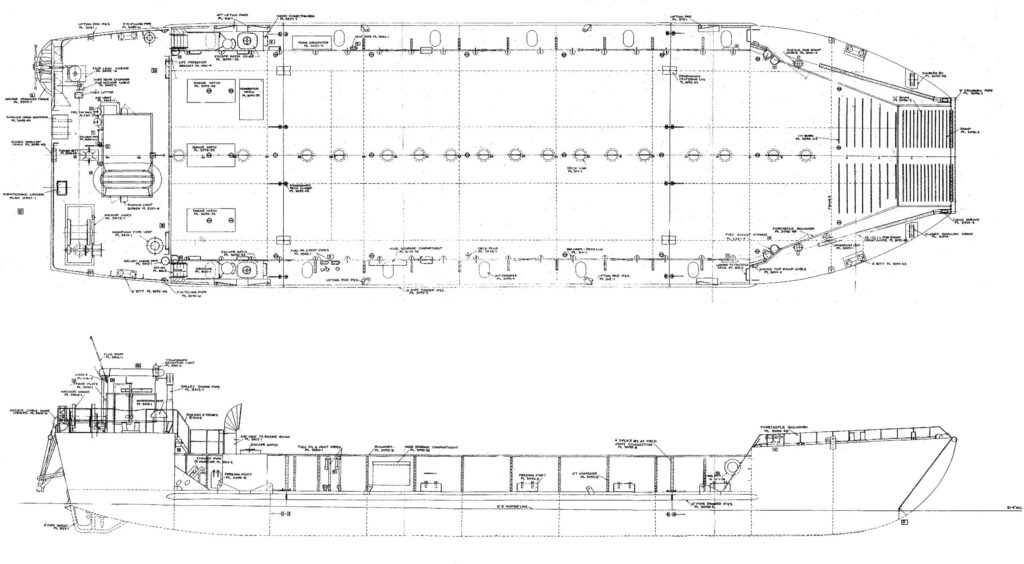
Full plans
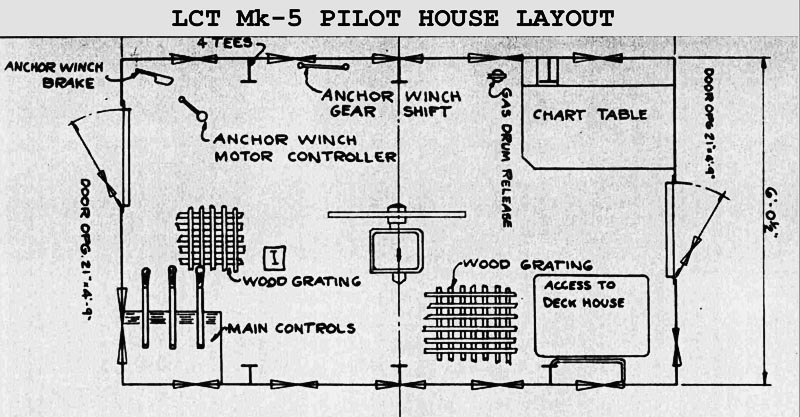
Pilothouse
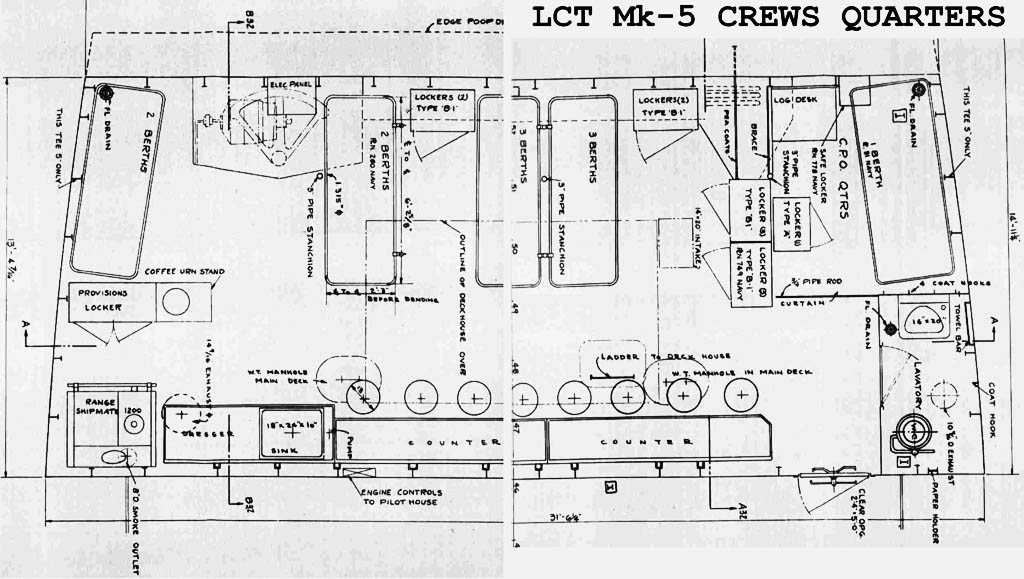
Crew quarters
Production
Bison Shipbuilding, NY: 301
Mare Island Navy Yard, CA: 216
Pidgeon Thomas Iron Works, TN: 156
Quincy Barge Builders, IL: 110
Kansas City Steel, KS: 49
Mount Vernon Bridge, OH: 46
Missouri Valley Bridge, KS: 44
Darby Corporation, KS: 42
Manitowoc, WI: 1
The British obtained two modified units, supplied via lend-lease: LCT(6) 627,629 transferred to Britain on 21 Jan 1944, None lost. A few were also passed onto the Soviet Navy.
US losses: LCT(6) 548, 579,582, 593, 597,612, 714, 777.823, 961,963, 983,984, 988, 998.
Originally rated as Landing Craft, Tank (LCT(6)) they were redesignated in 1949 LSU (Utility Landing Ships) and then LCU (Utility Landing Craft) on 15 April 1952 for Korea, versatile service craft.
30 units ended as target ships in 1946 Bikini atomic tests. Some were later reclassified as YFU. Some were redesignated YLLC and used for cargo only in the 1960s (shore commands).
LCUs 1273,1330,1363,1452,1463,1374 modified for Arctic service in 1948-1949.
LCU 1460 was lost at sea in 1952. LCU 815 was stricken in 1956 and LCU 569,676,767,1258,1288,1362,1447,1453,1454 in 1957. LCU 638,700, 779,1174,1225,1271, 1278 in 1958; LCU 1538 in 1959; LCU 1212,1244,1367,1429 were transferred under MDAP (Military Aid Programs) in 1959.
They took part in the Landing at Inchon in particular. A few were also used in Vietnam by South Vietnamese forces.
In 1971, 25 were still active, most transferred via MDAP.

Author’s three views of an LCT-6

British LCT Mark 6 camouflaged for D-Day, Osprey profile.
⚙ LCT(6) specifications |
|
| Displacement | 284 short tons (258 t) |
| Dimensions | 119 ft 1 in x 32 ft 8 in x 3 ft 4 in (36.3 x 9.96 x 1.02 m fwd) |
| Propulsion | 3 shafts 225 hp (168 kW) Gray marine diesels |
| Speed | 7 knots (13 km/h; 8.1 mph) |
| Range | 700 nmi (1,300 km) at 7 kn (13 km/h) |
| Armament | 2× 20 mm AA gun mounts, 4x 0.5-in cal. M2 Browning AA |
| Protection | Wheelhouse: 20 lb, Gun shields: 10 lb |
| Payload | 150 short tons (136 t) of cargo, see notes |
| Crew | 12 |
LCT Mark 7 (1944)
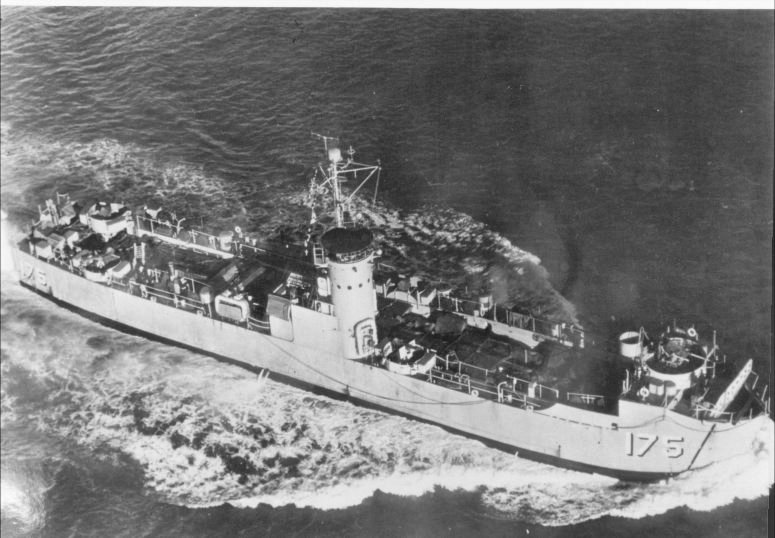
The Mark 7 a large LCT made to carry troops as much as tanks. In 1944 the design, inspired by the LCI (Landing Craft Infantry) was 203 feet long but eventually its designation was changed to Landing Ship Medium (LSM). Its new variant was capable of 12 knots and saw service in the Pacific. They were never operated at D-Day. 558 were built. They were used as regular transports, and several dozen converted during construction in specialized roles. They saw some service in the early Cold War, but most were transferred under the MoD under MDAP or sold to private shipping companies. Thus will the object of a dedicated article next year.
Rough specs:
530/900 long tons stabdard/FL, 203 ft 6 in x 34 ft (62.03 x 10m) draft from 3 ft 6 in (1.07 m) forward to 8 ft 3 in (2.51 m) aft
Powered by two Fairbanks-Morse/GM Cleveland diesels 2,800 shp (2,088 kW).
Top Speed 13.3 knots (24.6 km/h; 15.3 mph), Range 5,000 nmi (9,300 km) at 7 knots
It could carry 5 medium tanks or 3 heavy tanks or 150 tons of payload, six LVTs or nine DUKWs when used as floating dock.
Crew 54 troops, 2× 40 mm, 4-6× 20 mm AA.
LCT Mark 8 (1945)
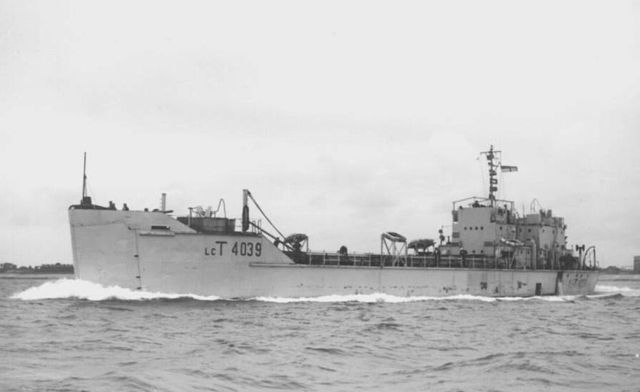
LCT(8)-4039 HMS Parapet in 1945
These were heavy British landing crafts designed by Thornycroft for the far east, by late 1944. They entered service from mid-1945. Much refined, roomier, better in all aspects for long voyages, they saw intensive action in the last 1945 amphibious operations against the Japanese, on the Burma-Malay front. Numbered LCT(8)-4001 to LCT(8)-4200. Only 40-50 were completed albeit Conways specified some completed until 1947.
Due to their long career, brand new modern design, they are going to be studied on a dedicated article in the future.
⚙ specifications |
|
| Displacement | 1,017 tons maximum |
| Dimensions | 231.2 x 38 ft x 4 ft 8 in () (70.5 x 12 x 1.42/1.57 m |
| Propulsion | 2 shafts, 4× Davey Paxman 12TPM engines 1,600 bhp (1,200 kW) |
| Speed | 8 knots (15 km/h; 9.2 mph) cruise, 12.5 knots max |
| Range | 4,000/2,500 nautical miles at 8/10 kts |
| Armament | 4x 20 mm Oerlikons |
| Protection | None |
| Payload | 8x 30-ton tanks/13x 3-ton trucks/350 tons cargo |
| Sensors | Nav radar added 1945 |
| Air Group | |
| Crew | 25-37 |
LCTs variants
Armament
The LCTs depending on their yard of origin had British (40mm) QF 2-pounder “pom-pom” mounts being gradually replaced by the faster firing 20 mm Oerlikon cannon. The Bofors 40 mm was also widely used, and proved that the LCT was an excellent gunfire support vessel.[2] Various machines guns were often mounted for self-defence from aircraft and small boats, often two to four in the .30-calibre (7.62 mm) and .50-calibre (12.7 mm), range depending on the operating country. Some models were fitted with a pair of ‘Fast Aerial Mine’ launchers near the bow.
Several special purpose versions were created for use during the Normandy landings:
Landing Craft Tank (Rocket) (LCT(R))
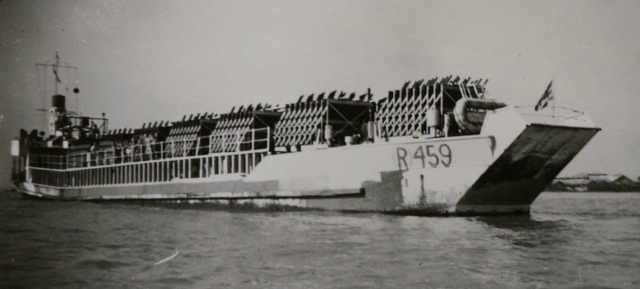
These were essentially older LCT(2/3) modified to fire salvoes of three-inch RP-3 rockets
The Landing Craft Tank (Rocket) or LCT(R) emerged for the idea of equipping now aging Mk.2 and Mk.3 Landing Craft Tank (LCT) in 1943 to bring massive, close fire support, saturating beach defences with either 972 or 1,044 rockets befire even any landing. Bith British and U.S. forces used theml on D-Day, Normandy landings, but also Italy, and the Far East in 1945.
The front loading door was welded shut, an additional strenght deck was installed above its bay to mounting rocket launching racks. The storage space below it, former tank deck could still provide some additional crew space, covered by simple canvas. Later wooden partitions were made. They were also fitted with a Type 970 radar used for rangefinding and navigation. They were often upgraded with Paxman diesel engines using petrol.
The 5-inch (130 mm) rocket projectors fired successive salvoes remotelly triggered from the wheelhouse. The rest of the 17 crewmen took shelter in the compartimented below-deck space. Thes rockers used cordite-filled tubes for initial projection, and these rockets carried each a still potent 7-pound (3.2 kg) HR warhead. LCT(R) operated on each beach area on D-Day, perhaps a dozen, and llaunched twenty-four salvoes designed to blanket up to 1,000 yards (910 m) in depth. Like naval artillery their failed to meet their objectives like at Omaha Beach which “cleaned” beach was completely missed. The system was successful enough to soldier at Inchon as well (Korea).
Landing Craft Guns (Large) (LCG(L))
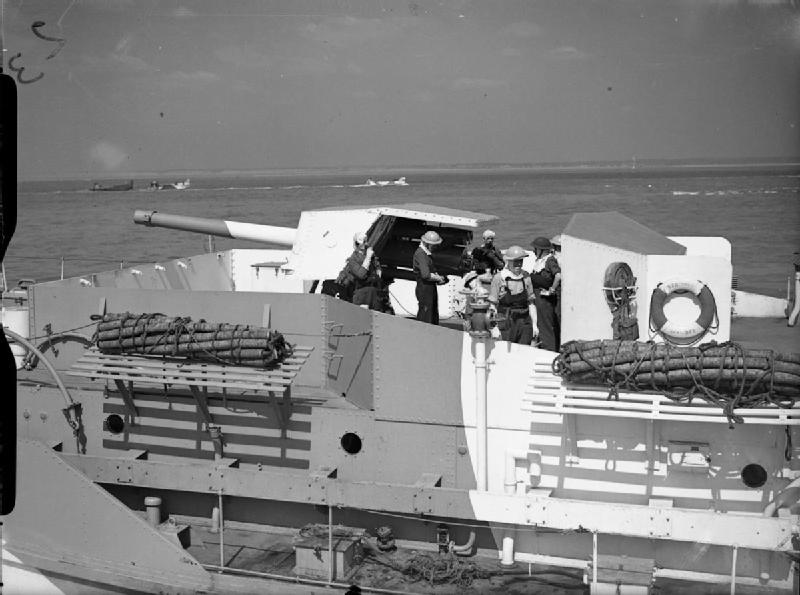
Close view on the BL-4.7 inches guns of a LCG(L) on D-Day.
This variant was armed with two QF 4.7 inch guns, eight Oerlikon 20 mm AA guns and two 2-pounder pom-poms. They acted as near-beach gunboats, very close thans to their low freeboard. In both cases, they did not beach and provided a longer close-in gunfire support compared to the LCT(R).
The Landing Craft, Gun (Large) was a fire support vessel converted from earlier LCT Mark 3/4. They received a stronger welded deck to carry two QF 4.7-inch Mk IX** or BL 4.7-inch Mk I naval cannons (primary) and defended by many 20mm Oerlikon guns.
Sub-variants:
LCG(L)(3): Based on the LCT(3), two deck guns
LCG(L)(4): based on the LCT(4), superfiring after turret.
Anti-air armament steadily improved and went from just two 20mm Oerlikon/2-pdr ‘pom-poms’ near the bridge to twin 20 mm mounts, the last three LCG(3)s having two extra 20mm single Oerlikon. The LCG(L)(4) bolstered no less than seven 20mm Oerlikon guns in individual positions.
The LCG(L) brought medium range fire support very close to the beacch with radio calls setup on platoon radioman models. Three were lost in Operation Neptune (British naval part of Overlord) and two lost in Operation Infatuate (the assault on Walcheren, Battle of the Scheldt). They were called “mini destroyers” by a BBC broadcast of the time, and thus could still be able to deal with incoming E-Boote in case or deal with armed Marinefährprahm landing craft. They did not saw action beyond WW2.
Landing Craft Tank (Armoured) (LCT(A))
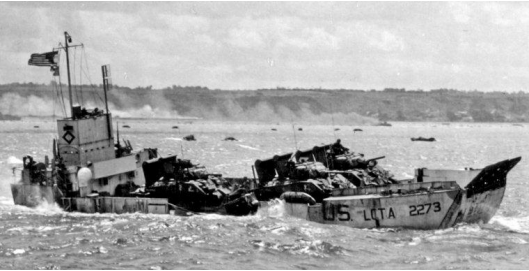
LCT(A) in rough seas src
They were designed for the first wave, with additional armour protection on crew stations and bow doors. There was a heavy wooden ramp enabling the two forward tanks to fire forward above the walls while underway. These were all LCT Mk.5s of US construction provided under Lend-Lease for Mediterranean operations and later “reverse lend-leased” back to the U.S. for D-Day. Picture
Before their pennant, the prefix LCT(a) was painted, often in red. Otherwise ther still resembled regular LCTs.
The Royal Marine Armoured Support Group was formed solely to carry out an important but short-lived role in the initial assault on German held France in 1944. Namely, to man guns mounted on board landing craft to fire against shore defences during the run-in to the landing beaches, and by using the beached landing craft, to provide artillery fire in support of the first waves of infantry to land until the artillery of the army was ashore. The weapons used were the 95mm howitzers mounted as the main armament on obsolete Centaur IV close-support tanks that were shackled to the decks. See MOD file for full caption, etc. (IWM)
Landing Craft Tank (self-propelled) (LCT(SP))
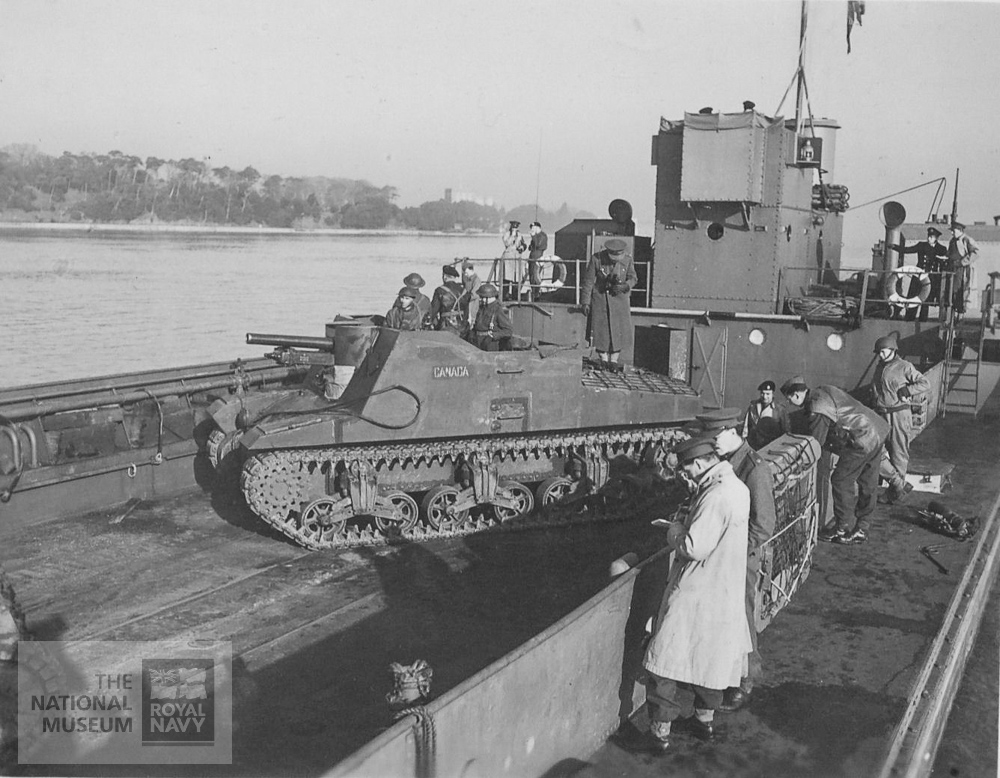
Photo: This not a LCT(SP) but can give an idea. Photograph, circa 1942, showing a Sexton self propelled gun on board a Mark 4 Landing Craft Tank (LCT) during trials. src
They carried self-propelled guns for fire support. US vessels had 155 mm “long tom” guns, while British variants used the M7 Priest 105 mm called “Landing Craft Tank (High Explosive)” or (LCT(HE)).
Landing Craft Tank (Concrete Buster) (LCT(CB))
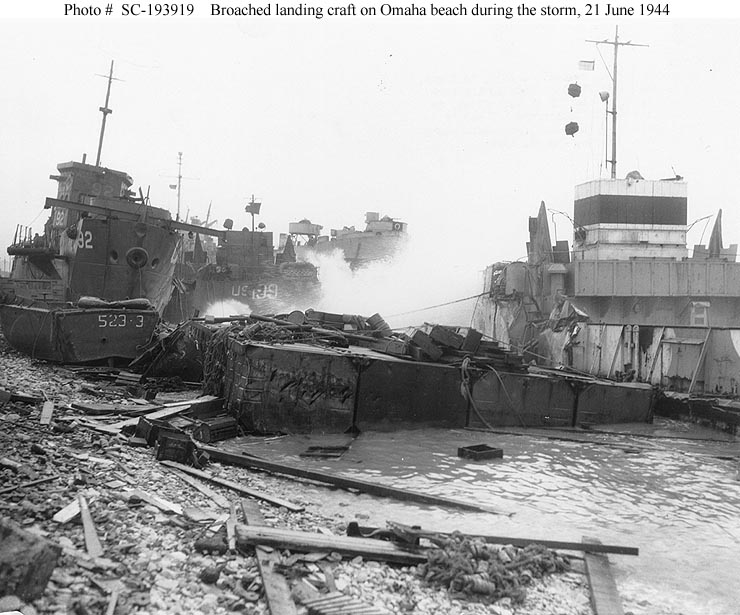
HM LCT(CB)-2337 (Concrete Buster), Sub Lieutenant R. W. Rawlings RNVR in command, Invasion of Normandy, Sword Beach, 6 June 1944. Abandoned at Omaha Beach, 20 July 1944. src
A related variant carried three British Sherman Firefly tanks fitted and their long range, 17-pounder high velocity gun, to breach fortifications. They were converted from LCT(5):
Displacement 285 t. 114′ 2″ x 32′ 8″ x 3′ 6″. 3x Grey Marine 6-71 Diesel engines, 1 Diesel-drive 20Kw 120V. D.C. generator. 675shp, 10 kts, 700 nm/7 kts. 150 short tons. Fuel Capacity Diesel 80 Bbls The wheelhouse was protected by the regular 2-1/2 inches and the 20 mm Oerlikon kept their 2-in gun shields.
Landing Craft Tank (Hospital) (LCT(H))
The Landing Craft Tank (Hospital) was only used for casualty evacuation. One of these specaious conversion was used as a floating bakery at Normandy after the beachhead was consolidated to feed the troops. They were less known than the larger, tailored LST(H).
Landing Craft Tank (Flak) (LCT(F))
LCTs with specialised weaponry used as floating anti-aircraft batteries. These were often manned by mixed army and navy crews. Others were modified after the war for uses such as dredging.[2]
LCTs in action

See also WW2 British amphibious Opetations and US amphibious Operations.
At D-Day for example, LCTs were deployed in second waves (after the launch of the infamous Sherman DDs) in the second wave at Utah Omaha, Gold, Juno, Sword. At Omaha, not on all sectors, adequate tank support for troops of the 1st and 29th Infantry Divisions was sorely lacking. Despite the situation British forces ordered not to send the LCTs before the beac were secured after the first wave. LCts came with the second wave to avoid indeed remaining coastal artillery fire: They would have been sitting ducks.

Not to expose LCTs, the first wave was to be supported by self-propelled amphibious tanks, the infamous “Duplex Drive” of which the bulk were provided by Sherman DDs. The artificial buoyancy was provided by the large volum of air trapped inside a tall impermeable skirt attached to a frame and maintained high up. This obliged to modify the tank as well, welding all around a support metal skirt at the mudguard level, so above the drivetrain, on which was soldly, hemtetically attached the skirt. The second was to fit at the rear a rudder and propeller activated by the main tank transmission hence the “DD”. Once the tank had landed, the tranmission was decoupled to port full power on the tracks, but they were moving as well when swimming for additional motion. The engine deck was modified to avoid seeping too much water spray with an exhaust muffler coupled with a pipe. The idea was to launch them from a regular LCT, ramp lowered, and tyey would float to their destination, thus avoid exposing their carrier. Unfortunately bad weather, which already delated from 24h the Normandy landing was greenlight on June 6th, and this cost most of the DDs deployed. In these choppy seas, water rushed above the “bathtub” formed by these skirts and the pumps were not enough to avoid the tank sinking. For this reason the crew was dismounted, sitting over the tank in case. The driver was however unfortunate enough to be inside, un-bottones and with his hatch open to escape quickly. Many drown with their tanks however.
LCTs in the cold war
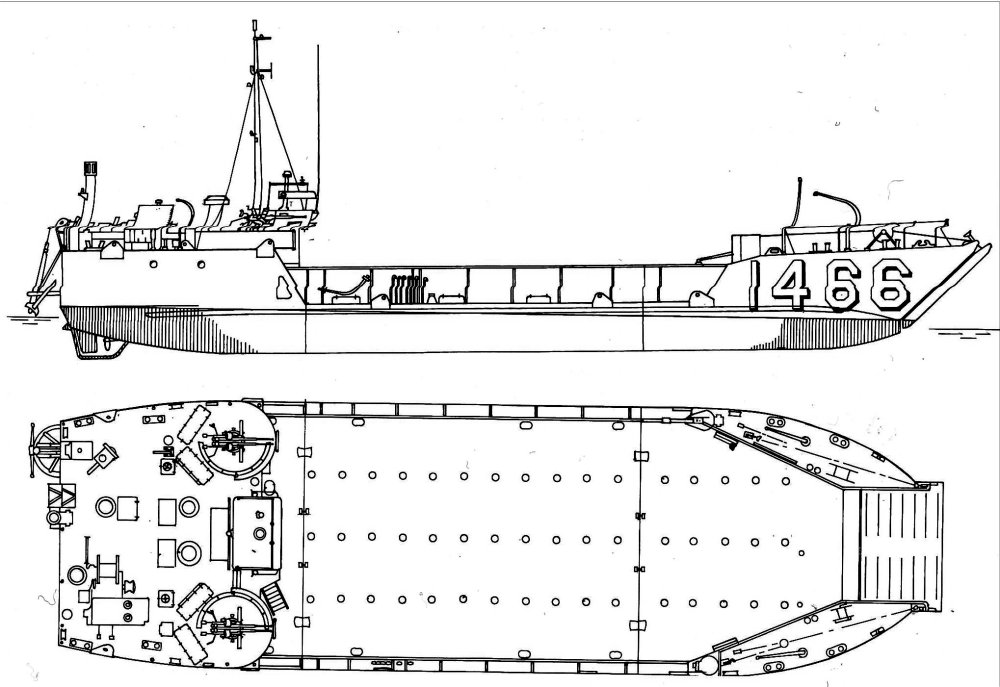
Legacy: The LCU-1466 class
LCTs remained in active duty quite long postwar, many were loaned/given under MDAP to US friendly nations as well as NATO ones. By early 1949, the egeneral designation was changed for LSU, and then landing craft utility (LCU). LCU 1466-, 1610-, 1627-, and 1646 sub-classes were a modified postwar Mark 5 design. Saw action in Vietnam War as harbor utility craft (YFU) not amphibious assault as feeder notably carrying goods from supply ships. In 1964, NASA converted one LCT Mk.5 for astronaut recovery training. This unique bat was renamed “MV Retriever”.
Today, tanks and other AFVs are carried via Airlift or National Defense Reserve Fleet freighters with the last generation of landing craft, the Landing Craft Air Cushion (LCAC) still used for assault by the Marines.
Surviving vessels:
-By August 2007, one wartime LCT(5)-203 renamed Outer Island was still used on Lake Superior as dredge/construction barge.
-LCT(6)-1433 wa sused as fishing/merchant vessel in Kodiak (Alaska) as Cape Douglas.
-LCT(2)(R)-147 that provided support at Operation Torch in North Africa was used for clandestine immigration (to Israel) post-war. She is now on display at the Naval Museum in Haifa.
-British LCT(3)-7074 was a D-Day veteran decommissioned in 1948, later presented to the Master Mariners’ Club of Liverpool as club ship, renamed Landfall. She was resold as floating nightclub by the late 1990s and was acquired by the Warship Preservation Trust, moored at Birkenhead then by January 2006 without maintenance as the company went bankrupt, she sank on site by April 2010. Refloated on 16 October 2014 she was towed to Portsmouth for renovation, completed in summer 2020 and installed on a land display at the D-Day Story museum in Southsea, 24 August 2020.
Many Wrecks had been discovered and explored also, LCT(4)-728 rotting at the Port of Poole close to LCT(4)-510, used as barges in the 1950s.
In 2020, LCT 326 was rediscovered off Bardsey Island, Wales under 90 metres (300 ft), which sank with all hands.
LCT(1)-A6, was submerged close to the archaeological site of Phalasarna, West Crete, safter being sunk in 1941 (Battle of Crete)
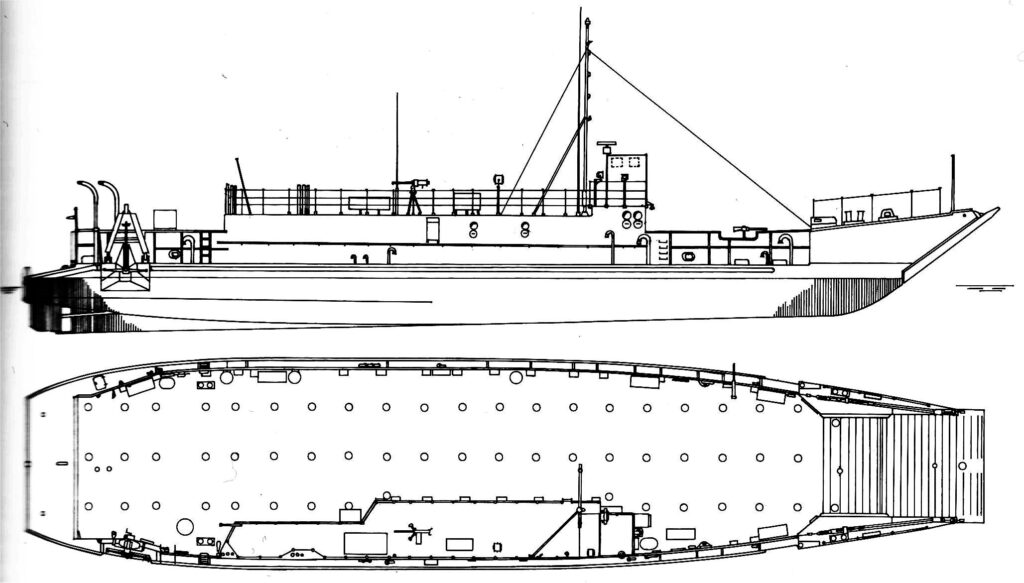
LCU-1610 class, last evolution before the LCAC.
They were powered by two Detroit 12V-71 Diesel engines, twin shaft, 680 hp sustained, with Kort nozzles for better agility for 11 kts (12.7 mph, 20.3 kph) 1200 miles range at 8 knots
Dimensions: Length 134.9 feet (41.1 meters), Beam 29 feet (8.8 meters). Displacement: 200 tons (203.21 metric tons) light; 375 tons (381.02 metric tons) full load
Capacity was 170 tons (172.73 metric tons), 125 tons of cargo in military lift, armed with two Broning M2HB, 14 crew, and provided a LN 66 or SPS-53; I band radar.
Read More/Src
Books
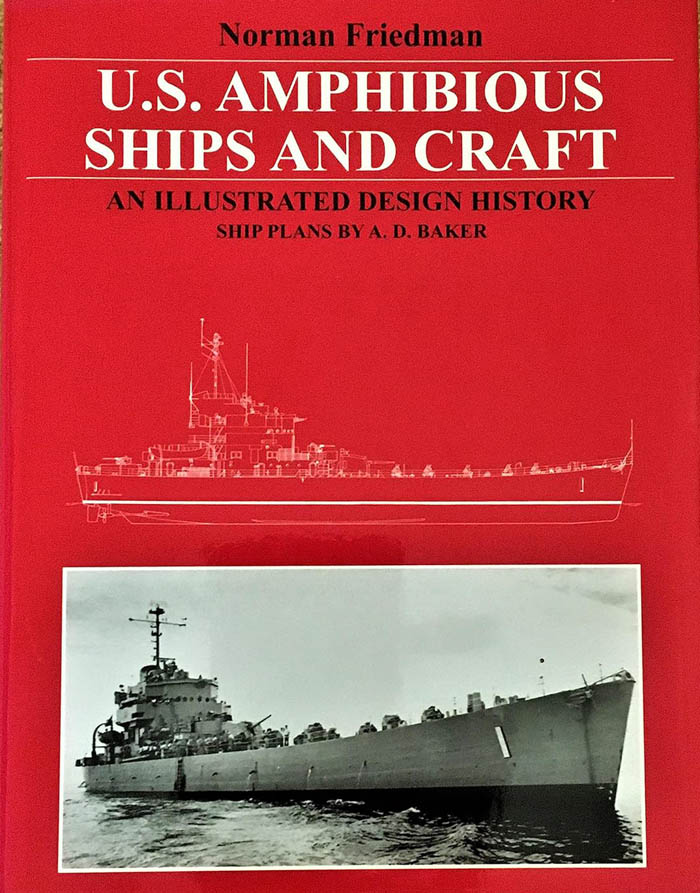
Fisher, Stephen & Hewitt, Nick (2020). “Warship Notes: Resurrecting LCT 7074”. In Jordan, John (ed.). Warship 2020. Oxford, UK: Osprey
Fox, Derek (March 2021). “The Resurrection of Landing Craft Tank 7074”. Warship International. LVIII (1)
Bendon, Michael (2014). The Forgotten Flotilla: The Craft of Heroes Greece, Crete and North Africa – 1941, Michael Bendon
U.S. Amphibious Ships and Craft: An Illustrated Design History, Norman Friedman, Naval Institute Press, 2002 – 659 pages
Links
ww2lct.org lctevolution.htm
web.archive.org/ ww2lct.org/ tin_armada.htm
http://ww2lct.org/history/stories/tin_armada.htm
shipbuildinghistory.com/ lct5.htm
shipbuildinghistory.com/ lct6.htm
navsource.org 18idx.htm
navsource.org 20idx.htm
2lct.org lct_a.htm
globalsecurity.org/ lct.htm
ww2lct.org/ mk6main.htm
ww2lct.org mk5main.htm
yorkship.home.comcast.net
combinedops.com /LCT
nthistorymuseum.org bisonshipgal-1.html
history.navy.mil combined operation craft small scale drawings
hyperwar/ ONI-226.pdf
mrfa.org yfu-79
navyhistory.au
combinedops.com/ LC ROCKET.htm
en.wikipedia.org Landing_craft_tank
commons.wikimedia.org Landing_Craft_Tank
Videos
The D-Day Story and Landing Craft Tank 7074
Landing Craft Tank (Rocket) 452 bombards Southern French Coast; Operation Dragoon, August 15, 1944
Model Kits
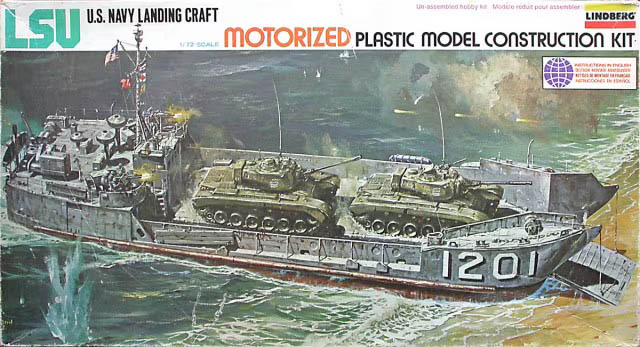
the full monty on scalemates.com

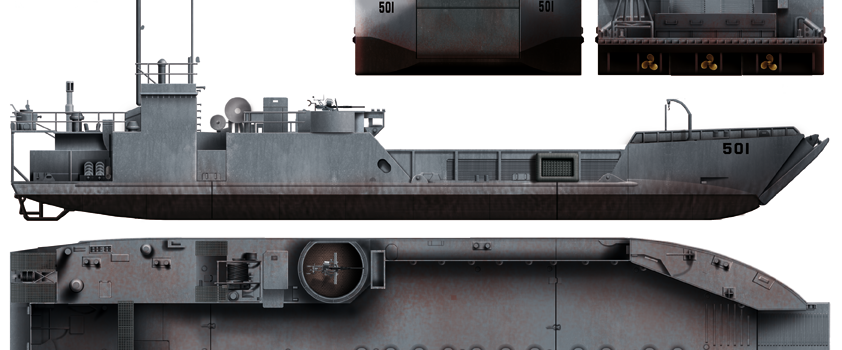


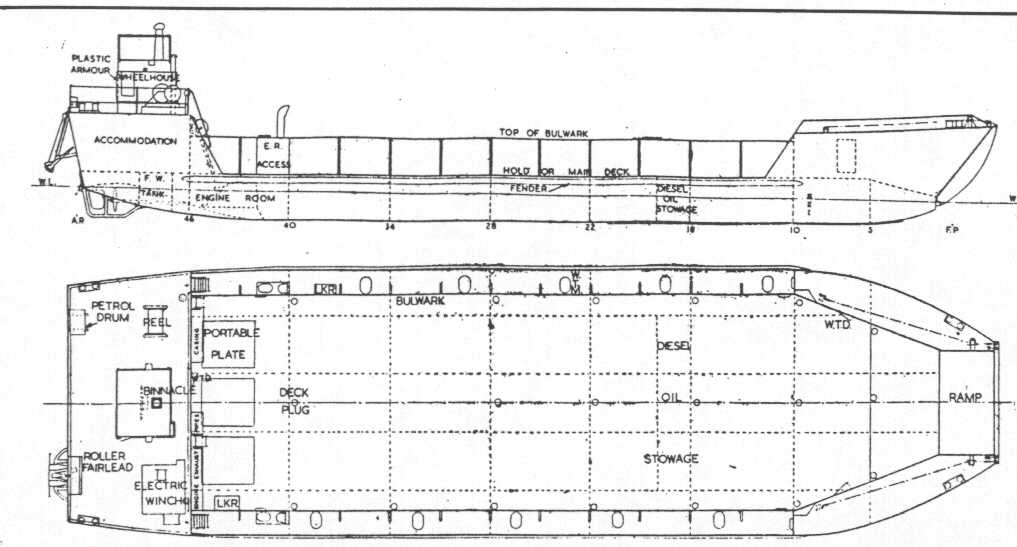
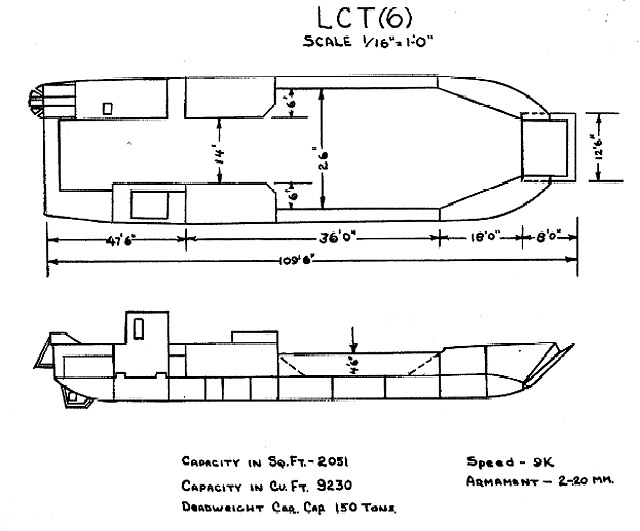
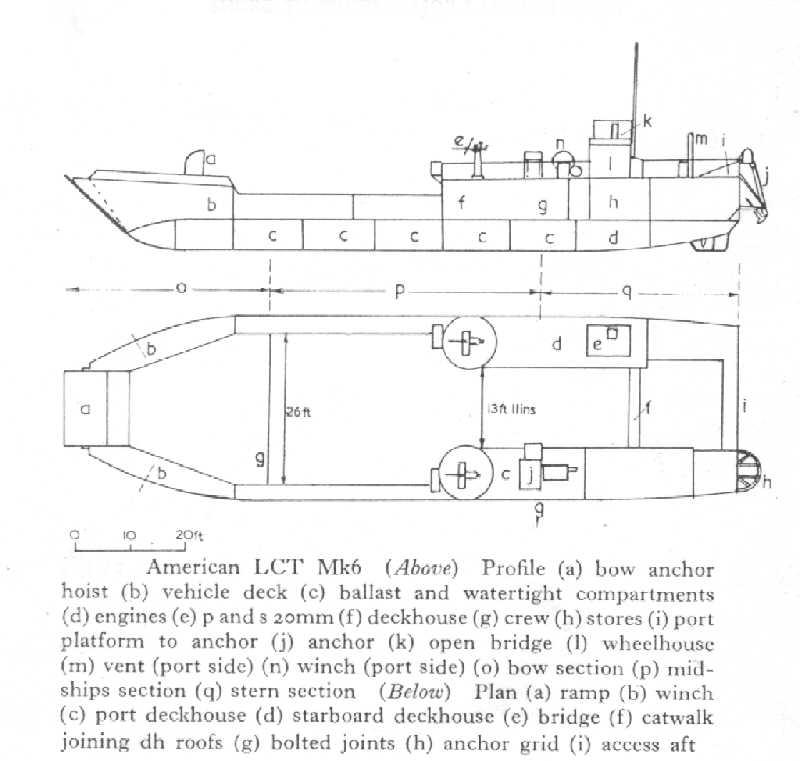
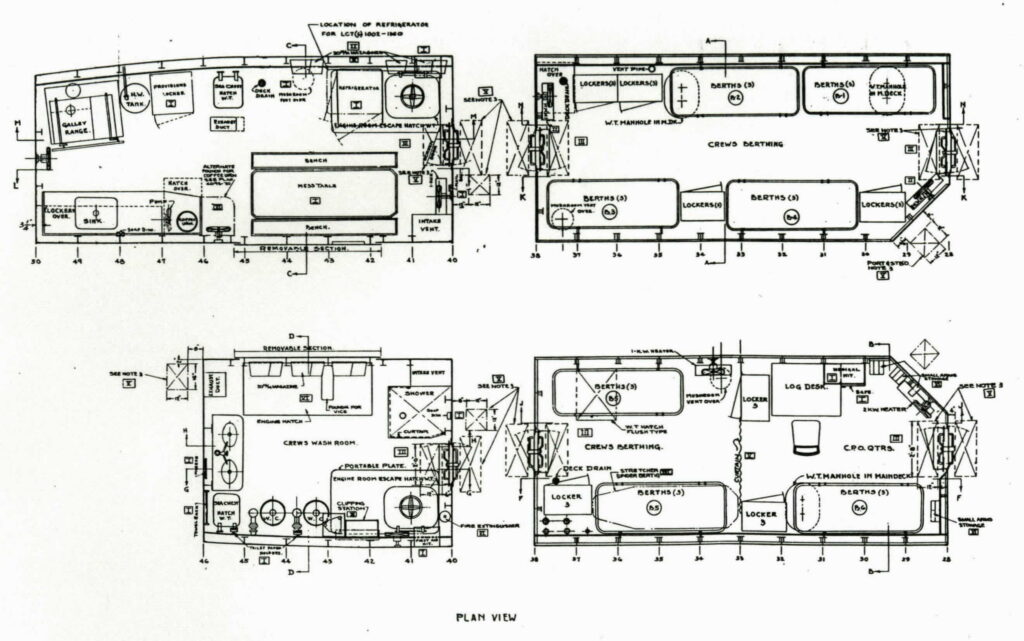
 Latest Facebook Entry -
Latest Facebook Entry -  X(Tweeter) Naval Encyclopedia's deck archive
X(Tweeter) Naval Encyclopedia's deck archive Instagram (@navalencyc)
Instagram (@navalencyc)





 French Navy
French Navy Royal Navy
Royal Navy Russian Navy
Russian Navy Armada Espanola
Armada Espanola Austrian Navy
Austrian Navy K.u.K. Kriegsmarine
K.u.K. Kriegsmarine Dansk Marine
Dansk Marine Nautiko Hellenon
Nautiko Hellenon Koninklije Marine 1870
Koninklije Marine 1870 Marinha do Brasil
Marinha do Brasil Osmanlı Donanması
Osmanlı Donanması Marina Do Peru
Marina Do Peru Marinha do Portugal
Marinha do Portugal Regia Marina 1870
Regia Marina 1870 Nihhon Kaigun 1870
Nihhon Kaigun 1870 Preußische Marine 1870
Preußische Marine 1870 Russkiy Flot 1870
Russkiy Flot 1870 Svenska marinen
Svenska marinen Søværnet
Søværnet Union Navy
Union Navy Confederate Navy
Confederate Navy Armada de Argentina
Armada de Argentina Imperial Chinese Navy
Imperial Chinese Navy Marinha do Portugal
Marinha do Portugal Mexico
Mexico Kaiserliche Marine
Kaiserliche Marine 1898 US Navy
1898 US Navy Sovietskiy Flot
Sovietskiy Flot Royal Canadian Navy
Royal Canadian Navy Royal Australian Navy
Royal Australian Navy RNZN Fleet
RNZN Fleet Chinese Navy 1937
Chinese Navy 1937 Kriegsmarine
Kriegsmarine Chilean Navy
Chilean Navy Danish Navy
Danish Navy Finnish Navy
Finnish Navy Hellenic Navy
Hellenic Navy Polish Navy
Polish Navy Romanian Navy
Romanian Navy Turkish Navy
Turkish Navy Royal Yugoslav Navy
Royal Yugoslav Navy Royal Thai Navy
Royal Thai Navy Minor Navies
Minor Navies Albania
Albania Austria
Austria Belgium
Belgium Columbia
Columbia Costa Rica
Costa Rica Cuba
Cuba Czechoslovakia
Czechoslovakia Dominican Republic
Dominican Republic Haiti
Haiti Hungary
Hungary Honduras
Honduras Estonia
Estonia Iceland
Iceland Eire
Eire Equador
Equador Iran
Iran Iraq
Iraq Latvia
Latvia Liberia
Liberia Lithuania
Lithuania Mandchukuo
Mandchukuo Morocco
Morocco Nicaragua
Nicaragua Persia
Persia San Salvador
San Salvador Sarawak
Sarawak Uruguay
Uruguay Venezuela
Venezuela Zanzibar
Zanzibar Warsaw Pact Navies
Warsaw Pact Navies Bulgaria
Bulgaria Hungary
Hungary

 Bundesmarine
Bundesmarine Dutch Navy
Dutch Navy Hellenic Navy
Hellenic Navy Marina Militare
Marina Militare Yugoslav Navy
Yugoslav Navy Chinese Navy
Chinese Navy Indian Navy
Indian Navy Indonesian Navy
Indonesian Navy JMSDF
JMSDF North Korean Navy
North Korean Navy Pakistani Navy
Pakistani Navy Philippines Navy
Philippines Navy ROKN
ROKN Rep. of Singapore Navy
Rep. of Singapore Navy Taiwanese Navy
Taiwanese Navy IDF Navy
IDF Navy Saudi Navy
Saudi Navy Royal New Zealand Navy
Royal New Zealand Navy Egyptian Navy
Egyptian Navy South African Navy
South African Navy






























 Ukrainian Navy
Ukrainian Navy dbodesign
dbodesign